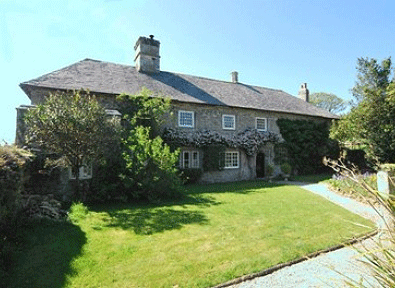The history of 16th century Trevithick Barton
This Cornish country house was home to an Admiral of the fleet who sailed with Captain Cook, as well as Sir Robert Walpole’s Lord Chancellor

Tucked away in the undulating fields and narrow laneways of Cornwall is the Grade II listed 16th century Trevithick Barton. References to ‘Trevithick' first appeared in the 1300s and it is thought it could have originally been part of a large manor house or even medieval monastery. However, this country house is most renowned for formerly being owned by an Admiral of the Fleet who sailed in the Pacific with Captain Cook, and a Lord Chancellor in Sir Robert Walpole's cabinet.
Despite its early reference, in 1303, details about the house do not appear until the 1530s when it was the home of a Thomas Trevythick [sic]. By 1558, when Mary I died and Elizabeth I took the throne, the house passed to John Trevithick of St Ewe, who was leasing it to Thomas Selicke, who was in the house with his wife Elizabeth and daughter Jane.
However, it was only in the early 1600s, in the final years of the reign of Elizabeth I that more detailed references of Trevithick Barton appear. In 1602, deeds show the property was owned by John Trevithick senior, with his wife Elizabeth and son Hugh. The house and property continued to pass to members of the Trevithick family, until in August 1612 John Trevithick sold it to Anthony Mapowder. However, by 1620 Mapowder had assigned the property to John Hickes, who in turn leased it to various occupants, including a clerk, Stephen Medhopp of St Martyns, and in 1633 it was home to merchant John Mayow.
Trevithick Barton continued in the hands of the Hickes family throughout the years of the civil war and the Commonwealth in the 17th century. By 1720, a full survey of the property gives us a glimpse of what the farm was like at this time. It was described as ‘offer[ing] uncommon advantages of profit and pleasure - the mansion house built of stone'. It later goes on to describe all the farm buildings and crops, including fields of asparagus, a full dove house, warren of over two acres, and river full of trout.
In 1734, a descendant of the first John Hickes, also named John, passed away and left his estates and lands to Peter Lord King, who was Lord Chancellor in Robert Walpole's cabinet between 1725 and 1733. However, King also passed away in the same year and so Trevithick passed to King's wife, Ann Lady King Dowager Baroness of Ockham. After this time, Trevithick Barton passed through a number of owners and by the early 1800s the property was owned by Arthur Kempe, Admiral of the Fleet.
Arthur Kempe had a distinguished naval career, first entering the Royal Navy as a captain's servant and rising through the ranks so that by 1764 he was midshipman on HMS Dolphin. However, one of his most significant career moments was during 1772 while sailing to Australia, New Zealand and the Pacific Islands with explorer, Captain Cook, on HMS Adventure. During this journey he was promoted to lieutenant and by 1780 was promoted to captain and then in 1799 to rear-admiral. He also fought during the French Revolutionary War and Napoleonic Wars and by 1821 was promoted to Admiral of the Red, or Admiral of the Fleet, the highest position within the Royal Navy.

* Subscribe to Country Life and up to £50
Sign up for the Country Life Newsletter
Exquisite houses, the beauty of Nature, and how to get the most from your life, straight to your inbox.
Admiral Kempe passed away in 1822, at which time Trevithick passed to his son, Charles. In 1841, the tithe map and apportionment clearly show Trevithick, covering almost 150 acres at this time, owned by Reverend Charles Trevanion Kempe and occupied by William Vincent. The 1841 census reveals farmer William Vincent was 36 years old and in the house with his wife Elizabeth and their three sons, Nicholas, Oliver and Robert. The Vincent family also had three live-in servants at this time.
The Vincent family continued to live and farm at Trevithick during the early to mid 19th century and by the time of the 1871 census, William was recorded as 65 years old and ‘farmer of 144 acres employing own labourers and boys'. It was during the mid-Victorian period that the ownership of the farm passed to Richard Davey, MP for West Cornwall in 1857-1868, and also Deputy Lieutenant of the County of Cornwall. William Vincent died in 1875 and the farm and house passed to his eldest son, Nicholas Gill Vincent.
Nicholas Vincent continued at Trevithick until the 1890s when it became the home of Henry Vellanoweth. The 1901 census records 37 year old Henry was in the house with his wife, 30 year old Nora, and their two young children, Kathleen and Thomas, along with one house servant. The Vellanoweth family continued at Trevithick during the early 20th century and by the 1930s, tax records show it was home to Thomas Vallanoweth and was owned by a ‘A.J. Pengilly' of South Australia. Thomas Vellanoweth and his family continued to live at Trevithick during the 20th century and almost 100 years after his father first moved to the house, Thomas was still recorded at Trevithick in the 1990s.
Trevithick Barton has been situated in this quiet spot in the hills of Cornwall for around 500 years, but its early history is shrouded in mystery, with stories of it being part of a monastery or a very large medieval manor house. Today, the earliest part of the house dates back to the 16th century, with stone floors featuring reused stone with mouldings, timber beams, granite moulded doorway, and a former back-to-back fireplace. However, not only has Trevithick been altered many times, it has a number of mysterious anomalies where doors have moved, hidden plasterwork appears in the roof, and an old cellar is believed to be hidden under the floor. The documentary evidence does not point to Trevithick Barton ever been a monastic site, but it appears a visit from Time Team may be the only way to answer the mystery once and for all.
* More details on Trevithick Barton * Visit my blog - The House Historian
Country Life is unlike any other magazine: the only glossy weekly on the newsstand and the only magazine that has been guest-edited by HRH The King not once, but twice. It is a celebration of modern rural life and all its diverse joys and pleasures — that was first published in Queen Victoria's Diamond Jubilee year. Our eclectic mixture of witty and informative content — from the most up-to-date property news and commentary and a coveted glimpse inside some of the UK's best houses and gardens, to gardening, the arts and interior design, written by experts in their field — still cannot be found in print or online, anywhere else.
-
 London Craft Week: Rolls-Royce demonstrates the true beauty of real artisanship
London Craft Week: Rolls-Royce demonstrates the true beauty of real artisanshipA triptych of British nature scenes show that the difference between manufacturing and art is not as wide as we might think.
By James Fisher Published
-
 Name that dog: Country Life Quiz of the Day, May 13, 2025
Name that dog: Country Life Quiz of the Day, May 13, 2025One of Britain's most picturesque streets and Tom Brown's school find their way in to Tuesday's quiz.
By Country Life Published
